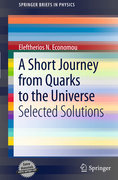
This book takes the reader for a short journey over the structures of matter showing that their main properties can be obtained even at a quantitative level with a minimum background knowledge. The latter, besides some high school physics and mathematics, consists of the three cornerstones of science presentedin chapters 1 to 3, namely the atomic idea, the wave-particle duality, and the minimization of energy as the condition for equilibrium. Dimensional analysis employing the universal constants and combined with “a little imagination and thinking”, to quote Feynman, allows an amazing short-cut derivation of several quantitative results concerning the structures of matter. This book is expected to be of interest to physics, engineering, and other science students andto researchers in physics, material science, chemistry, and engineering who may find stimulating the alternative derivation of several real world results, which sometimes seem to pop out the magician’s hat. Answers the questions 'What the World and its parts are made of?', 'How?' and 'Is there a hidden underlying simplicity in the immerse complexity and diversity?' Brief introduction to the characteristic methodology of physics Showsthe relationship to natural constants Concise introduction to dimensional analysis of relations in physics Deep insights into the laws of physics with no more than lower undergraduate level knowledge of physics and mathematics Provides convincing evidence that a 'little thinking' (Feynman) can go a long way inderiving relations, which otherwise would require an extensive investment of time and effort Offers a panoramic view of 'the forest' of the physical world complementing thus the usual approach which emphasizes details of particular 'trees' INDICE: Preface. Introduction: The World according to Physics Levels of the structure of mater. PART 1: Three key-ideas and a short-cut. The atomic idea. The wave-particle duality. Equilibrium and minimization of total energy. Dimensional analysis: A short-cut to physics relations. PART 2: This World, this small World, the great. From quark and gluons to hadrons. From protons and neutrons to nuclei. From nuclei and electrons to atoms. From atoms to molecules. From atoms and molecules to solids and liquids. Planets. Stars, dead or alive.Cosmology. Revisiting photons.
- ISBN: 978-3-642-20088-5
- Editorial: Springer Berlin Heidelberg
- Encuadernacion: Rústica
- Páginas: 144
- Fecha Publicación: 01/06/2011
- Nº Volúmenes: 1
- Idioma: Inglés
